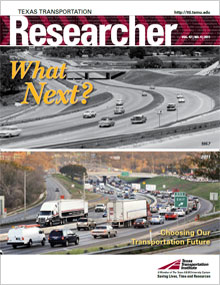TxDOT Shares Best Practices and Research Results on YouTube
You might not expect to find many folks on YouTube interested in “automated flagger assistance devices” or “development of very thin overlay systems.” But that’s not the case on a newly launched YouTube channel sporting these very titles.
The channel, titled “bestpracticesvsrs,” is sponsored by the Texas Department of Transportation (TxDOT) Office of Research and Technology Implementation (RTI) as part of its implementation support and technology transfer of the department’s state- and federally funded research program. To date, after a year online, the channel is experiencing a significant and steady number of hits — considering the limited interest the public generally has in such focused and technical subjects.
What exactly are video summary reports, or VSRs as they have been coined?
“It’s a two- to three-minute video that highlights a best practice from a TxDOT district, a worthwhile research finding, or successful implementation of a new technology,” explains David Dennis, the coordinator of electronic media at the Texas Transportation Institute (TTI). Dennis has worked for the last year with RTI staff, TxDOT research project directors and researchers from TTI, as well as those from other universities participating in the Research Management Committee (RMC) program, to populate the YouTube channel. The results are a variety of transportation topics from all around Texas representing multiple TxDOT districts and universities.
RTI began this technology transfer initiative a few years ago as the social media wave geared up, and YouTube’s popularity spread to the business and corporate world. The first three research-related VSRs were produced on contract by TTI, pilot-tested with a limited internal TxDOT audience and then shared by RTI briefly at a national U.S. Department of Transportation peer exchange meeting. “The enthusiastic and positive response to the pilot is what led us to expand the effort with more VSRs, and to include best practices, so that districts have a venue for exchanging ideas and solutions to problems,” says Rick Collins, director of TxDOT RTI. “We are getting a lot of good feedback that tells us this is an effective way to deliver a targeted, simple message, and for TxDOT staff to share information and success stories.”
VSRs are unscripted, short, impactful and inexpensive and always involve a TxDOT research project director or employee that has a story to tell. “We don’t tell them what to say — we just shoot the relevant footage and create a clear and interesting message,” says Dennis. “It’s not intended for training or complicated details, but only to pique someone’s interest so they know where to go if they need more information.”
Proof of success for this new technology transfer tool is in the numbers. YouTube statistics over the last three months on selected VSRs reveal that most postings are averaging about three to six hits a day, for a total of around 100 hits a month — even a full month or two after the initial posting. With subject matter like effluent limitation and cable median barriers, it’s actually quite phenomenal that the total upload views for the channel now exceed 3,000.

